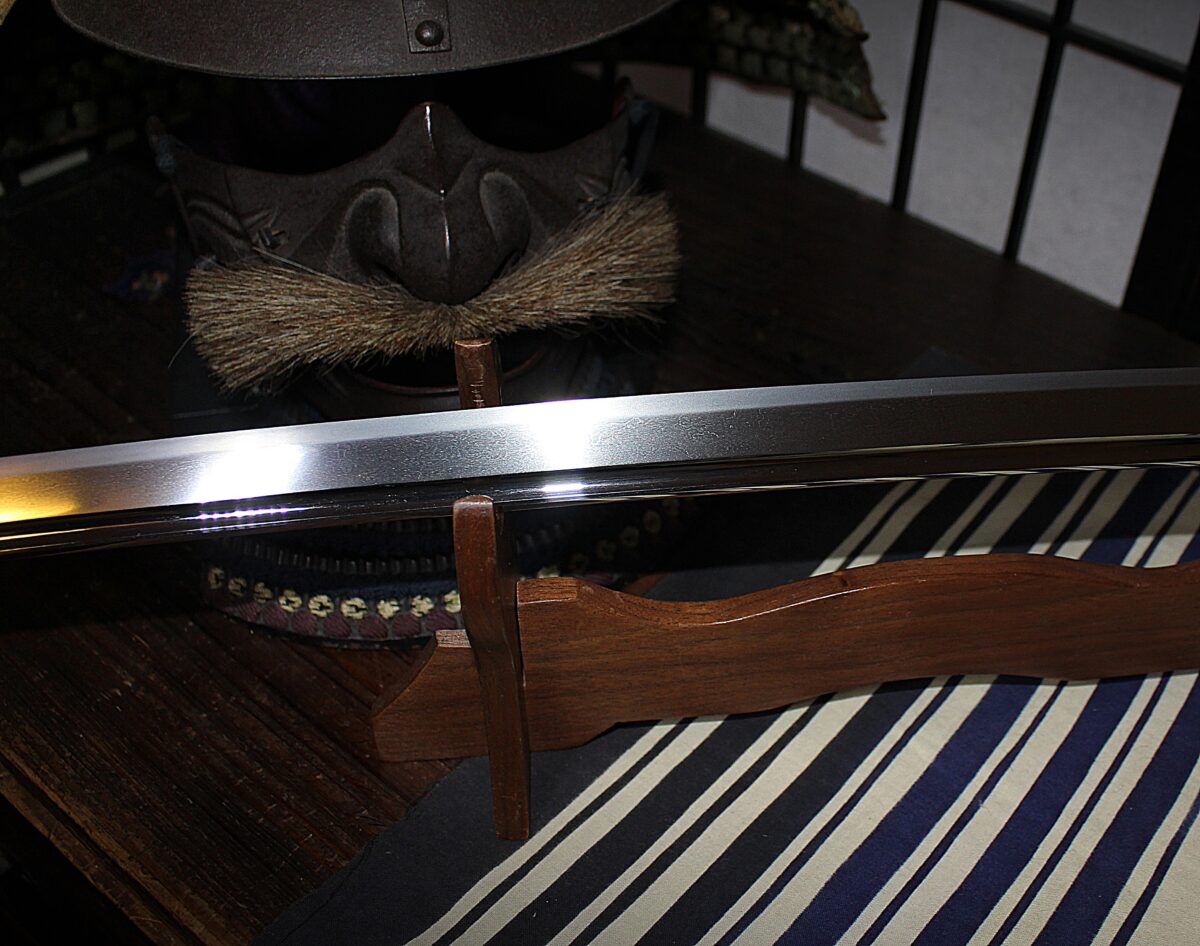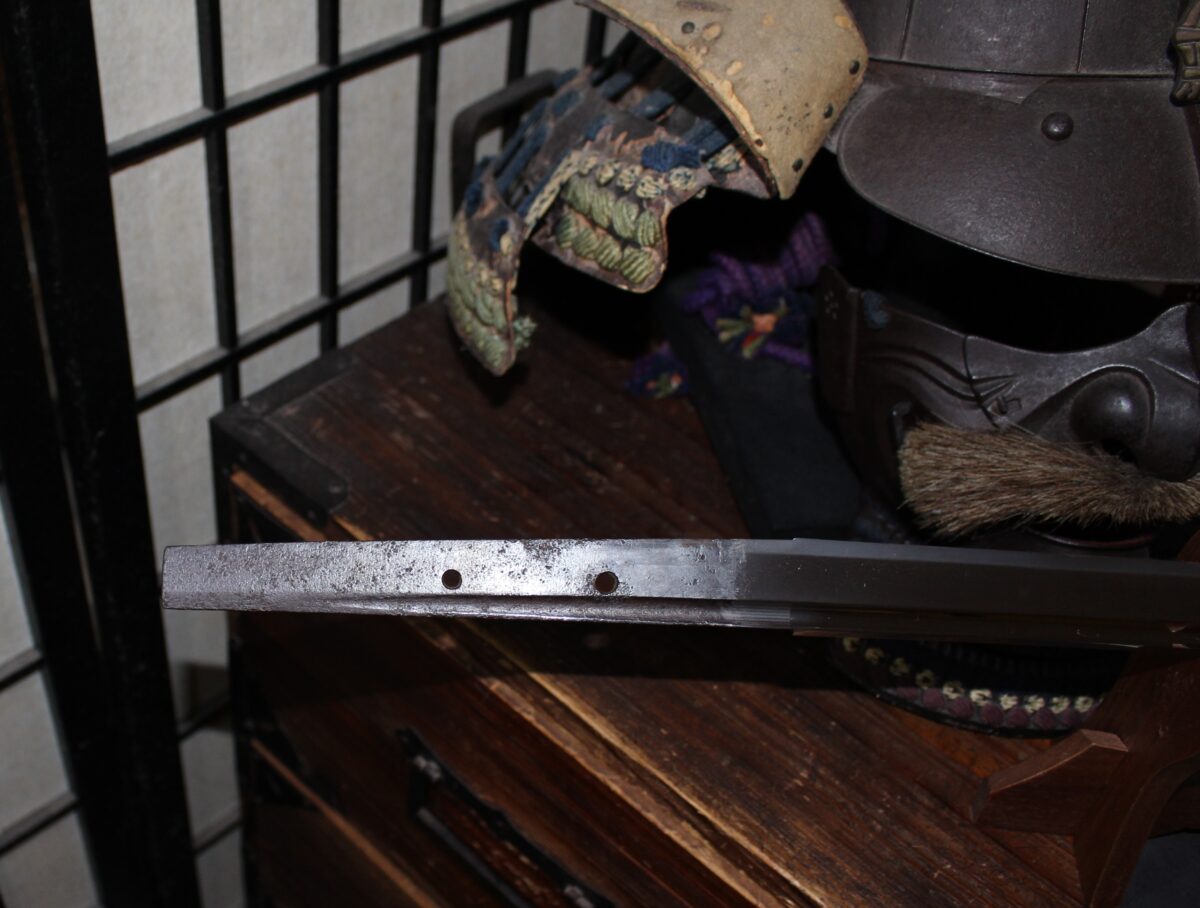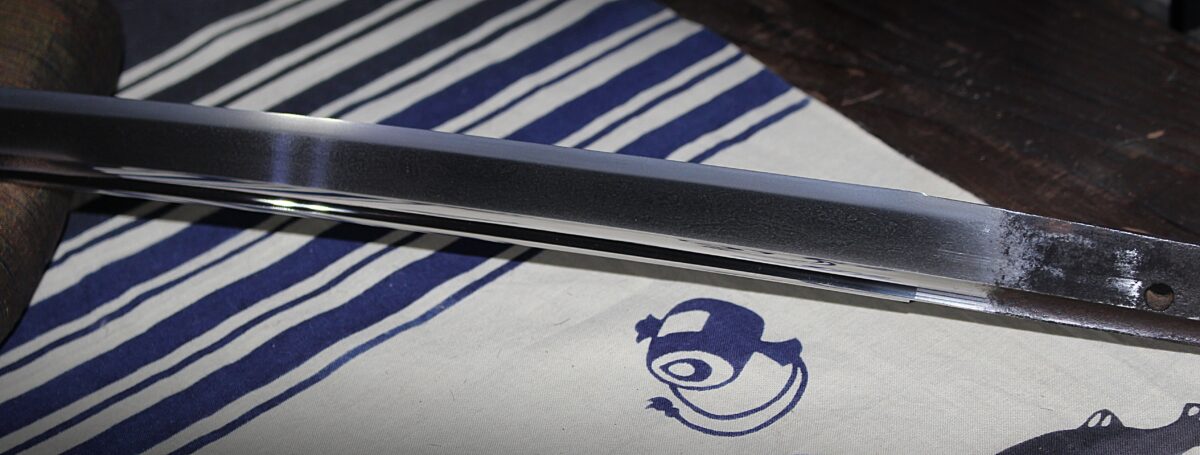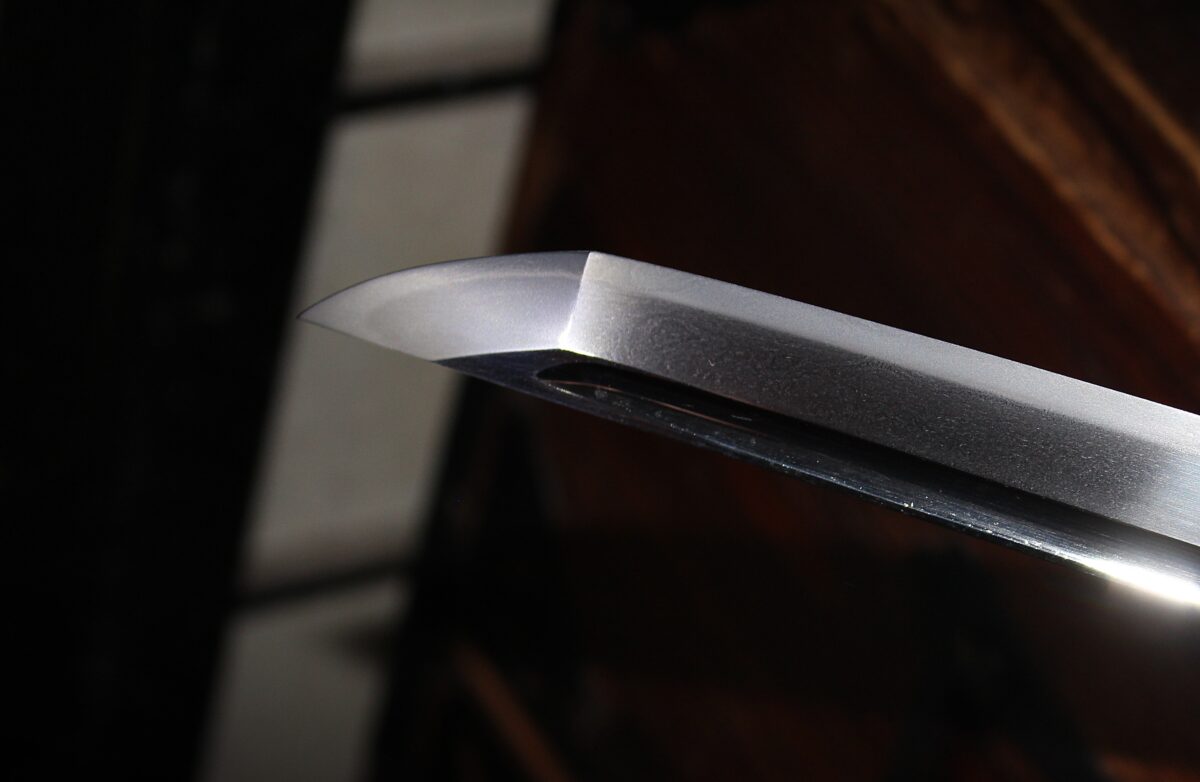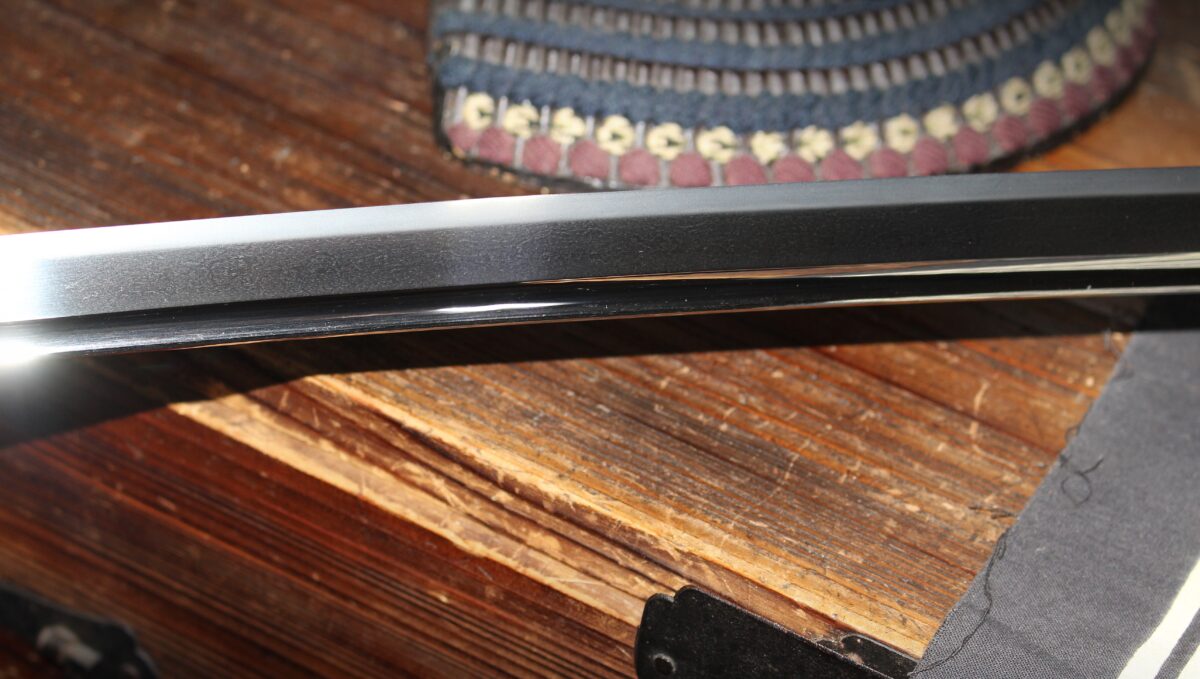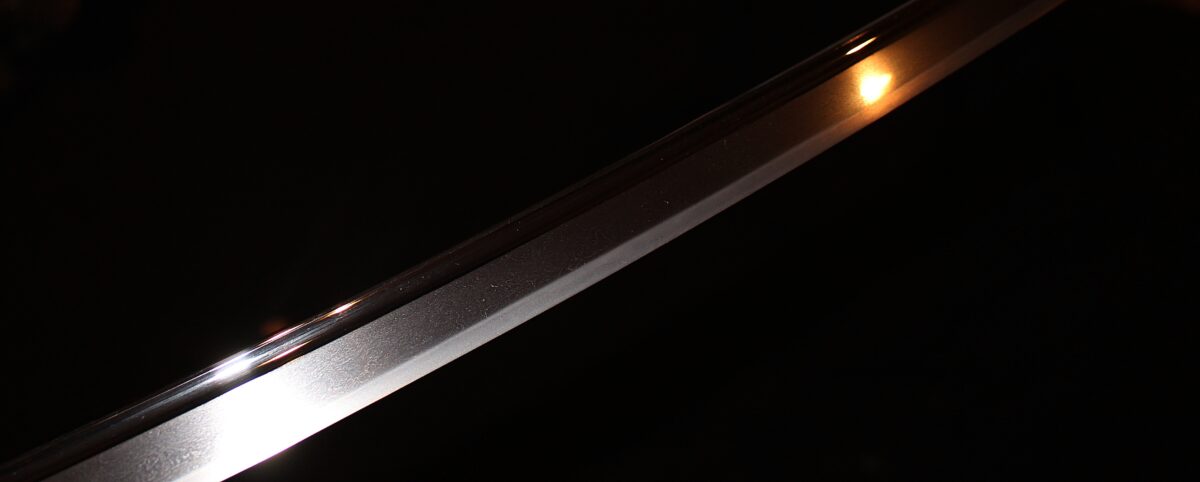Juyo Token Tachi by Reisen Sadamori
Juyo Token Tachi by Reisen Sadamori
A swordsmith of the Kongobyoe school in the Chikuzen province, active during the Nambokuchu period, works of Reisen Sadamori, and in general of this school, are quite rare. Named after the harbor town, Reisen in Hakata City, he was a sword smith ruled by the Southern Imperial Court, as evidenced by a rare extent work; a tanto inscribed Shohei 25.
The Kongobyoe school had its own style that exhibits both Yamashiro and Yamato Influences.
Throughout history, works of this smith have been highly prized. This smith has a very high 100 point rating in Hawleys. Considering the rarity of this smith, a large percentage of his works are considered highly valued and thus rated Juyo Token by the NBTHK. “There are 15 Juyo blades by this smith, and given the rarity of his work, speaks to a high regard held for his swords. Furthermore, held in even higher regard, there is a signed Juyo Bijutsuhin tanto by this smith. The signature is 筑州冷泉貞盛, Chikushu Reisen Sadamori.” (Darcy Brockbank, nihonto.ca)
Typical Reisen Sadamori for Kantei: Photo coutesy of Darcy Brockbank
My own research has found 6 out of 9 Reisen Sadamori examples that are Juyo Token.
There was a Juyo Token Reisen Sadamori in the famous Compton Collection. In Japan swords by this smith comand very high asking prices in upwards of 70,000,000 Yen.
Kongobyoe school swords were prized by Samurai for being extremely tough and break resistant. This helped them defeat the thick Mongol armor they encountered during the Mongol invasions.
The characteristics that define Kongobyoe swords are high quality jigane, thick kasane, chukissaki, and thin hososuguha hamon.
More specific traits of Reisen Sadamori are:
Sugata which is shinogi zukuri with iorimune, torisori of medium curvature, and compact chukisaki. Horimono is common. Pronounced tapering from motohaba to sakihaba is noticeable. Ubu nakago are commonly sotoba nakagojiri, made to resemble the shape of the wooden tablets used for grave makers.
Kitae which is itame mixed with mokume. Running areas of massame are common. Areas of ohada are also common. By description, when dealing with such, “ohada” and “shingane” can converge. (A similar characteristic called “Rai hada” can be found in Rai school blades.)
Hamon is characterized by hososugaha. Niogughi is uniformly tight and bright. Konie and small hatakari is common
In hand, these blades are very well balanced. For such menacing implements, these blades feel light in hand.
The specifics of this Juyo Token Reisen Sadamori are as follows:
Shape: Shinogi zukuri with iorimune. The mihaba is average with noticable difference between motohaba and sakihaba. The sori is of medium curvature in torizori and the kissaki medium but slightly compacted.
Forging Style: Itame with occasional mokume, occasionally nagare, becoming faintly masame in the ha of the monouchi. The hada is conspicuous, bright, and lustrous with chikei inserted. There is a slightly “whitish” cast to the jigane.
Hamon: Chusuguha, konie-deki, accompanied by kinsuji, nijuba, and uchinoke. The nioiguchi is uniformly tight and bright. Ko-nie is distributed within the yakiba to the ha with faint ko-ashi and yo inserted.
Boshi: Sugu with komaru with short kaeri, accompanied with modest hakkake, and ko-nie appearing.
Horimono: Bohi on both sashiomote and sashiura ending in kakinagashi about two-thirds the length of the nakago.
Tang: O-suriage with kiri yasurime, 2 mekugiana
Provenance: This sword has been directly attributed as a genuine work of Reisen Sadamori by the Nihon Bijutsu Token Hozon Kyokai (Society for the Preservation of Japanese Art Swords), an official extension organization of the Japanese Government. It holds this organization’s official designation of “JUYO TOKEN” (Important Art Sword). This designation is awarded only to those specimens that exhibit meritorious quality of workmanship and condition, and was so awarded to this sword on March 2nd, 1979. It was also featured in the NBTHK Publication of Token Bijutsu Issue #299 (1981). The shirasaya also illustrates direct attribution to “Chikuzen Reisen Sadamori”, brushed in ink (sayagaki) by the hand of Honma Kunzan, a respected authority in the Japanese sword community, and first chairman of the NBTHK which he co-founded in 1950. The sayagaki, as noted and signed by Honma Kunzan on the saya, was written on this sword in 1978.
Commentary: Reisen Sadamori is a member of the Kongobyoe School of Chikuzen province on Kyushu during the Nambokucho period. Kongobyoe works earlier than Muromachi period are exceedingly rare, and follow a style that is Yamato by general definition, but lies more accurately in a Yamato-den subcategory (majiwarimono), because of features of Yamashiro-den are also seen in them. They are noticeably individualistic even by provincial categorizations of the Koto age. Sadamori has works dating from the Shohei period (Southern Dynasty dating 1346-1370) which targets his general working time line. The form of this sword derives of the first part of the Nambokucho period with a medium mihaba, medium kissaki, with noticeable difference in width from the motohaba and sakihaba. The kasane is thick.
Examining the forging pattern, the influences of Chikuzen province are immediately evident in the well forged, dense, itame with mokume and insertions of chikei. The masame in the ha of Kongobyoe works lends to their general classification of Yamato-den style. The jigane has a very slightly whitish cast which in conjunction with the nagare (streaming) tendencies, is seen in swords from the Kyushu region. Hataraki of ko-ashi and yo insertions are modest and subdued, and are accompanied by ha hada.
The tightness of the forging in this piece is highly admirable. The width of the yakiba and boshi, in conjunction with the strength and distribution of nie and chikei, also indicates a very good state of preservation.
The blade accompanied by a certificate of registration as a Juyo token (Important sword) no. 6568 issued by the Nihon Bijutsu Token Hozon Kyokai (Society for the Preservation of the Japanese Art Sword), dated 1979.3.2
Nagasa: 69.3 cm Sori: 1.55 cm
Motokasane: 0.65 cm Kissaki Length: 3.35 cm
Motohaba: 2.9 cm Nakago Length: 18.9cm
Sakihaba: 1.95cm Nakago sori: 0.10 cm
Sakikasane: 0.40 cm
Price: Inquire
Contact us to set up a private viewing.



